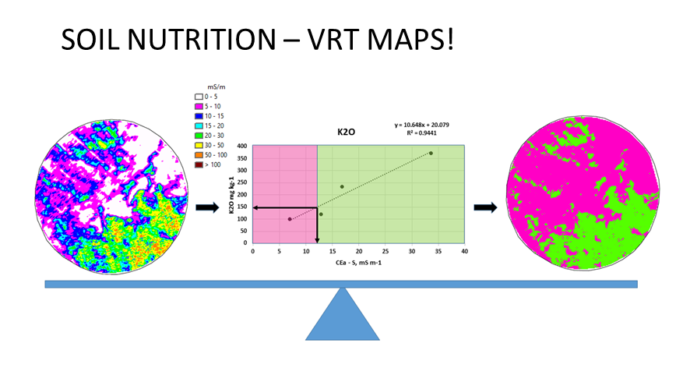The term VRT means “Variable Rate Technology”, and is closely associated with the central objective of Precision Agriculture, “to treat differently what is different”, that is, differentially distributing of seeds, fertilizers and other production factors considering the best agronomic standards in order to obtain the highest possible efficiency.
To build this type of maps, particularly from the point of view of nutrition, it is very helpful to have a map of the soil electrical conductivity (ECa), because we can relate the soil ECa with nutrients and quickly create a variable application map.
The example presented is the construction of a potassium map. Looking at the Figure, we can see that the soil ECa is related to the concentration of potassium and that relation is described by an equation (Y = 20.079 + 10.648 * X; R² = 0.9441), where Y is the concentration of Potassium in the soil and X the soil ECa; an ECa of 12 mS/m represents a soil potassium concentration of approximately 150 mg/kg of soil.
Considering the extraction of the crop, we can decide to treat this parcel differently with respect to potassium fertilizer. We can divide the parcel into two distinct zones of fertilization, putting more fertilizer in areas with potassium concentrations below 150 mg/kg and less in areas with potassium concentrations above this value. Geographic Information Systems can easily transform the ECa map (left map) to a management zone map (right map) considering the equation presented before.
With the management zone map two different amounts of fertilizer can be associated to it, and later on, injected in the VRT equipment console (on the tractor) in order to be applied in the field.
This is usually more complex because many of the available fertilizers in the market are composed by multiple nutrients. Apart from this question, it is also necessary to meet the price of the fertilizer itself, a very important variable in the agro-economic decision.
This can be even more complicated if we consider the potential productivity of the parcel. So far we have only considered the agronomic aspects of the best or worst concentration of nutrients, however, if we have zones within the parcel that produce twice as many of the others, then we must think about the economic aspects because the same nutrient has differentiated use rates and this, being an economic problem, is also an environmental problem. If we are putting nutrients in areas where they are not used, where are they going to? To the aquifers, to the water lines, etc.

